 Seated on a bench in Old Havana, Nilda Ayala reads the Granma newspaper with her index finger pointing to the page.
Seated on a bench in Old Havana, Nilda Ayala reads the Granma newspaper with her index finger pointing to the page.
“Did you see the big news?”, the elderly lady asks me while peering over the pages of the official Communist Party of Cuba’s (PCC) publication. On the front page reads the announcement by Raúl Castro and Barack Obama regarding the reestablishment, as of yesterday, of diplomatic relations between Cuba and the United States since being frozen for 54 years.
“It’s amazing, it’s an incredible gesture of Obama, and of the people of the United States”, Ayala adds.
The rapprochement between the two countries came about after a long process of dismantling the stereotypes created by both governments of each other.
“In my youth the United States was presented as a country with severe racism, inequalities and exploitation, a country where people didn’t share solidarity”, recalls Mario Castillo, a 40 year old Cuban professor. “This gradually shifted. In the ‘90s, when the Soviet Union fell, the Cuban government began an effort to distinguish between the U.S. state and its society, films and literature; all of a sudden this image of a people we had never known appeared. A coming together between civil society groups from Cuba and the United States began after 2000, for example, with meetings between socialist youth groups, so that the North Americans could get to know the island and begin to pressure their government to change its attitude toward Cuba”.
In the streets of Havana the diplomatic breakthrough is all people are discussing, from those who interpret Obama’s decision as an admission of a failed policy toward the island, to those who expect that the arrival of North Americans will lead to increased economic capacity. What everyone agrees on, is that the decision by the US administration is not the result of charitable interest, but rather a pragmatic one.
“In the United States there are lobbying groups influencing both parties, especially representing agriculture, that have pushed the administration to change its policy towards Cuba. And the pressure coming from the leftist governments of South America – which are at the moment in the majority – was also strong”, according to Leonel González of the Cuban civil society organization Martin Luther King.
 The iron curtain that divides the two countries will gradually come down, yet the reestablishment of diplomatic relations doesn’t necessarily imply their normalization. “With the reestablishment of diplomatic relations and the reopening of the Embassies, today the first stage of the bilateral dialogue culminates and opens the way to the complex and certainly long process towards the normalization of bilateral relations”, declared the Cuban Minister of Foreign Relations Bruno Rodríguez, during the opening ceremony of the island’s embassy in Washington. For normalization to occur Cuba, placed some conditions, such as the restitution of territory where currently the Guantanamo naval base exists – a subject that is not even under debate in the United States – and the lifting of the blockade, supported by 59% of United States citizens, but nonetheless opposed by a part of the Congress, which is majority Republican.
The iron curtain that divides the two countries will gradually come down, yet the reestablishment of diplomatic relations doesn’t necessarily imply their normalization. “With the reestablishment of diplomatic relations and the reopening of the Embassies, today the first stage of the bilateral dialogue culminates and opens the way to the complex and certainly long process towards the normalization of bilateral relations”, declared the Cuban Minister of Foreign Relations Bruno Rodríguez, during the opening ceremony of the island’s embassy in Washington. For normalization to occur Cuba, placed some conditions, such as the restitution of territory where currently the Guantanamo naval base exists – a subject that is not even under debate in the United States – and the lifting of the blockade, supported by 59% of United States citizens, but nonetheless opposed by a part of the Congress, which is majority Republican.
Obama reiterated on several occasions that he will not abandon his goal of changing the predominant political, economic and social regime of Cuba. The United States government only recently removed Cuba from the list of state sponsors of terrorism, but continues to express concern for the human rights situation on the island.
“From our view we are concerned with the human rights situation in the United States, Europe and the entire world”, retorted Leonel González of the Martin Luther King Center in Havana. “In Cuba a ‘state of emergency’ was declared due to the war with the United States, which has limited some rights for example with regards to the use of the media. But at the same time there are millions of Europeans who are without work, so there’s a great violation of human rights there too”.
 Since the announcement of the diplomatic breakthrough (December of 2014) travel by United States citizens to Cuba has increased by 36% in relation to the previous year, and maritime and areal communication mechanisms have been restored. In addition, the estimated increase in GDP of the island for the first half of 2015 is 4%, while in 2014 it had been at 1.3%.
Since the announcement of the diplomatic breakthrough (December of 2014) travel by United States citizens to Cuba has increased by 36% in relation to the previous year, and maritime and areal communication mechanisms have been restored. In addition, the estimated increase in GDP of the island for the first half of 2015 is 4%, while in 2014 it had been at 1.3%.
US companies still are not operating in Cuba, however with the Foreign Investment Law passed in April of 2014 the economic reforms first begun in Cuba in the ‘90s – when support stopped from the Soviet Union after its fall – were deepened, and the existence of businesses with full or partial participation of foreign capital was legalized, representing 4% of the total. The law also foresees the further enlargement of the Mariel port to allow for the construction of a Special Development Zone, where companies can operate under special tariff and fiscal arrangements, an opportunity which undoubtedly will earn the attention of United States investors.
From its inauguration in January 2014, only seven companies have so far been authorized to operate in the Special Development Zone of Mariel. “The first investment approved for Mariel was for Richmeat, a 100% Mexican company in the foodstuffs sector. Currently bilateral trade between the island and Mexico is around 500 million dollars according to Cuban figures”, explains Juan José Bremer de Martino, Mexico’s ambassador in Habana.
Photos by Orsetta Bellani
Translation by Justin Coley



